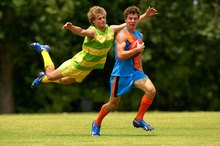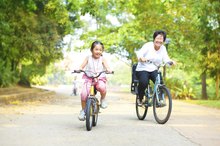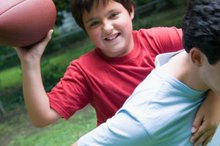Fitness Tips for 14 Year Old Girls
Parenting your 14-year-old girl is probably a trip -- a wild and wonderful trip. As she struggles to discover who she is and what she wants from life, your daughter can benefit from your advice about how to take care of her body. When you offer her fitness tips, keep your tone positive and upbeat. You might meet with some resistance, but be persistent.
Getting Started
Your daughter should shoot for 60 minutes of physical activity every day, according to the Centers for Disease Control and Prevention. She can break the hour into smaller increments spread throughout the day. Ideally, she should include a combination of aerobic, muscle-building and bone-building activities. Encourage her to focus primarily on the aerobic component, which should have a moderate or vigorous intensity. If she's an exercise newbie, suggest she start with brisk walking. Walking is free, doesn't require much coordination and is easy to squeeze into her schedule. If walking bores her or she wants variety, she can borrow home exercise videos from the local library, join a youth running group or take a beginner's ballet class, for example.
- Your daughter should shoot for 60 minutes of physical activity every day, according to the Centers for Disease Control and Prevention.
- If she's an exercise newbie, suggest she start with brisk walking.
Getting More Specific
Kickboxing for Young Girls
Learn More
When you consider what counts as physical activity, exercising for 60 minutes a day seems easier to accomplish. Moderate activity includes rollerblading, biking and volleyball, as well as pushing a lawnmower or vacuum cleaner. Three times a week, she should ramp up the intensity with more vigorous activities, such as running, hip-hop dance, swimming and aerobics. As far as muscle building, she can try weight-training activities by using resistance bands or hand weights. Or she can do simple body-weight exercises, such as push-ups and sit-ups. Activities that involve jumping, hopping and skipping -- including basketball, jump rope and gymnastics -- are great for building your daughter's bones.
- When you consider what counts as physical activity, exercising for 60 minutes a day seems easier to accomplish.
- Or she can do simple body-weight exercises, such as push-ups and sit-ups.
Doing It Right
Your daughter should kick off every workout with a brief warm-up including light cardio activity and dynamic stretching that involves smooth and repetitive motions of the muscles she'll be working. She should wrap up her workouts with an easy and relaxing stretching routine, targeting the muscles she just worked. She can learn specific stretches by going online, searching fitness books and magazines or taking a yoga or Pilates class. If your daughter is trying out an activity that requires strict adherence to form -- such as gymnastics or conventional strength training -- make sure a qualified adult professional oversees her progress and safety.
- Your daughter should kick off every workout with a brief warm-up including light cardio activity and dynamic stretching that involves smooth and repetitive motions of the muscles she'll be working.
- She should wrap up her workouts with an easy and relaxing stretching routine, targeting the muscles she just worked.
Staying Motivated
FAQ About Leslie Sansone
Learn More
If your daughter fears her social life will take a hit if she takes time for exercise, encourage her to exercise with friends. They can chat while walking or biking to school. After school and on the weekends, they can hit the pool or go ice skating together, for example. Whenever possible, support her fitness efforts by providing her with equipment, workout clothes that make her feel good about herself, transportation, your companionship if she desires it and moral support. Remember, she's more likely to stick with enjoyable activities that boost her confidence and self-image and suit her strengths and temperament. If she's unsure where her individual strengths lie, offer guidance, but don't push her.
- If your daughter fears her social life will take a hit if she takes time for exercise, encourage her to exercise with friends.
Staying Safe
If your daughter has a chronic health issue, speak to her pediatrician before she starts a new fitness program. If your daughter is involved in organized sports, confirm she's working with highly trained coaches who emphasize safety and the use of proper technique. At age 14, your daughter could probably handle tough coaching styles and deal effectively with disappointment, but keep an eye on things to make sure her training environment is ultimately healthy and positive. She should avoid diet and fitness behaviors that might harm her health, including obsessive exercising, extreme dieting and the use of steroids. If your daughter seems caught up in these behaviors, find a professional who can help her get back on track.
- If your daughter has a chronic health issue, speak to her pediatrician before she starts a new fitness program.
- If your daughter is involved in organized sports, confirm she's working with highly trained coaches who emphasize safety and the use of proper technique.
Related Articles
References
- Palo Alto Medical Foundation: Teenage Growth & Development -- 11-14 Years
- Centers for Disease Control and Prevention: How Much Physical Activity Do Children Need?
- Centers for Disease Control and Prevention: Aerobic, Muscle- and Bone-Strengthening -- What Counts?
- IDEA Health and Fitness Association: Strength Training for Kids
- KidsHealth: Motivating Kids to Be Active
- KidsHealth: Fitness and Your 13- to 18-Year-Old
Resources
Writer Bio
Judy Fisk has been writing professionally since 2011, specializing in fitness, recreation, culture and the arts. A certified fitness instructor with decades of dance training, she has taught older adults, teens and kids. She has written educational and fundraising material for several non-profit organizations and her work has appeared in numerous major online publications. Fisk holds a Bachelor of Arts in public and international affairs from Princeton University.









